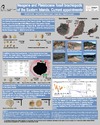Please use this identifier to cite or link to this item:
https://accedacris.ulpgc.es/jspui/handle/10553/11861
| Title: | Neogene and Pleistocene fossil brachiopods of the Eastern Islands. Current appointments. | Authors: | González, Eduardo Betancort-Lozano, Juan Francisco Meco, J. Lomoschitz, Alejandro |
UNESCO Clasification: | 240119 Zoología marina | Keywords: | Brachiopoda, Neogene, Pleistocene, Phylogeny, paleoclimatic indicators, North Atlantic | Issue Date: | 2014 | Conference: | IV Congress of Marine Sciences | Abstract: | Numerous specimens of fossil brachiopods have been found in the different fossiliferous outcrops of the Canary Islands. These fossils have been found in the deposits of Mio-Pliocene age of the eastern Canary Islands, described and illustrated in the work of Meco et ali. 2005 and in the outcrops interpreted as a tsunami deposits in Piedra Alta, Lanzarote, belonging to the Marine Isotope Stage 11 dated to circa 330 ka. 4 species of fossil brachiopods have been identificated: Terebratula sinuous Brocchi 1814, Lacazella mediterranea Risso 1826 Terebratulina caputserpentis (Zbyszewski, 1957) and Thecidium cf . digitatum (Sowerby 1823). These fossils provides stratigraphic and paleoclimatic taxonomic information. Furthermore, in order to compare the fossil brachiopods with present in the Canary Island, a reference collection is defined with specimens obtained from marine sediment surveys at Gran Canaria, La Palma and El Hierro, identifying 3 species: Argyrotheca barrettiatia (Davidson, 1866), Megerlia truncata (Linaeus 1767 ) and Pajaudina atlantica (Logan 1988). Se han encontrado numerosos especimenes de braquiópodos fósiles en los diferentes afloramientos fosilíferos de Canarias. Estos fósiles se han hallado tanto en los yacimientos de edad mio-pliocena de las Canarias orientales, descritos y cartografiados en los trabajos de Meco et ali. 2005, así como en los afloramientos interpretados como procedentes de un evento marino de gran energía o tsunami en Piedra Alta, Lanzarote, interpretados pertenecientes al Marine Isotope Stage 11 datado en circa 330 ka. Se han identificación 4 especies fósiles de braquiópodos: Terebratula sinuosa Brocchi 1814), Lacazella mediterranea Risso 1826, Terebratulina caputserpentis (Zbyszewski, 1957) y Thecidium cf. digitatum (Sowerby 1823), aportando información paleoclimática estratigráfica y taxonómica. Asimismo, con el objeto de comparar los braquiópodos fósiles con los actuales, se ha definido una colección de referencia actual con ejemplares obtenidos a partir de sondeos sedimentarios realizados en Gran Canaria, La Palma y el Hierro, identificándose 3 especies: Argyrotheca barrettiatia (Davidson, 1866), Megerlia truncata (Linaeus 1767) y Pajaudina atlantica (Logan 1988) |
URI: | https://accedacris.ulpgc.es/handle/10553/11861 | Source: | Book of Abstracts submitted to the IV Congress of Marine Sciences (Las Palmas de Gran Canaria, June 11th to 13th). 488 p. ISBN 84-697-0471-0 / ISBN 978-84-697-0471-4 |
| Appears in Collections: | Póster de congreso |
Page view(s)
101
checked on Jun 15, 2024
Download(s)
163
checked on Jun 15, 2024
Google ScholarTM
Check
Share
Export metadata
This item is licensed under a Creative Commons License

